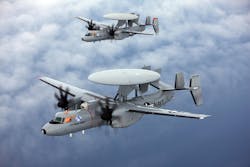Northrop Grumman to build nine E-2D radar surveillance planes with avionics and updated mission computer
PATUXENT RIVER NAS, Md. – U.S. Navy carrier airborne surveillance experts are asking Northrop Grumman Corp. to build nine E-2D Advanced Hawkeye carrier-based radar surveillance aircraft -- four for the Navy and five for Japan -- under terms of a $1.46 billion contract announced last month.
Officials of the Naval Air Systems Command at Patuxent River Naval Air Station, Md., are asking the Northrop Grumman Aeronautics Systems segment in Melbourne, Fla., for nine E-2D Advanced Hawkeye aircraft, to include over and above support.
The Navy Northrop Grumman E-2D is a tactical airborne early warning (AEW) aircraft designed to operate from aircraft carriers. The twin-engine turboprop aircraft has a distinctive antenna, and provides the carrier battle group with wide-area radar surveillance for enemy monitoring and combat air traffic control.
The E-2D Group 2 Plus has an avionics upgrade, and includes GPS satellite navigation in the aircraft's weapon system. It also has an upgraded mission computer and engines, compared to earlier models of the E-2D.
The E-2D's large saucer-like radar antenna mounted to the top of the aircraft, as well as other advanced avionics, enables it to detect hostile aircraft and missiles at extremely long ranges and vector Navy aircraft to intercept.
Northrop Grumman officials call the E-2D reconnaissance aircraft a "digital quarterback" to sweep ahead of Navy aircraft carrier strike groups, manage missions, and keep U.S. network-centric carrier battle groups out of harm's way. The aircraft provides battle management, theater air and missile defense, and multi-sensor fusion capabilities.
Compared with its E-2C predecessor, the E-2D has a new radar with mechanical and electronic scanning capabilities; glass cockpit; advanced identification friend or foe (IFF) system; new mission computer and tactical workstations; electronic support measures enhancements; and modernized communications and data link suite, Northrop Grumman officials say.
The plane is nearly 58 feet long, has an 80-foot wingspan, can fly faster than 300 knots, and can fly to altitudes as high as 37.000 feet. It carriers a crew of five: two pilots and three mission systems operators. The co-pilot also can act as a fourth mission systems operator.
The E-2D first flew in 2007, and Navy officials say they hope to procure 73 of these aircraft by 2022. These plans started going to the fleet in 2015.
Historically Northrop Grumman has managed the E-2 program from its facility in Bethpage, N.Y., but the company will assemble the aircraft in Melbourne, Fla. The company no longer builds aircraft at its Bethpage facility.
On this order Northrop Grumman will do the work in St. Augustine and Melbourne, Fla.; Liverpool, Edgewood, Greenlawn, and Owego, N.Y.; Indianapolis; Menlo Park, El Segundo, Woodland Hills, and Torrance, Calif.; Rolling Meadows, Ill.; Aire-sur-l’Adour, France; Windsor Locks, Conn.; and other U.S. locations, and should be finished by March 2029.
For more information contact Northrop Grumman Aeronautics Systems online at www.northropgrumman.com/who-we-are/business-sectors/aeronautics-systems, or Naval Air Systems Command at www.navair.navy.mil.
About the Author
John Keller
Editor-in-Chief
John Keller is the Editor-in-Chief, Military & Aerospace Electronics Magazine--provides extensive coverage and analysis of enabling electronics and optoelectronic technologies in military, space and commercial aviation applications. John has been a member of the Military & Aerospace Electronics staff since 1989 and chief editor since 1995.
